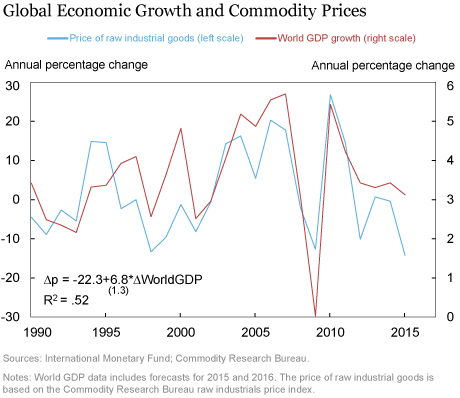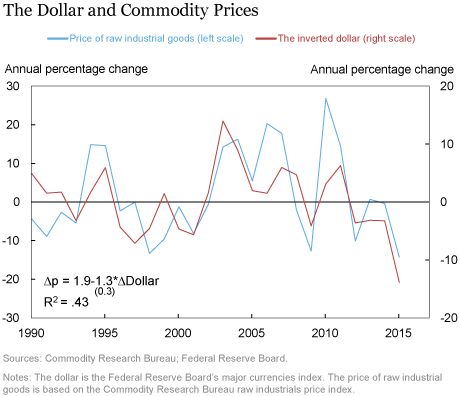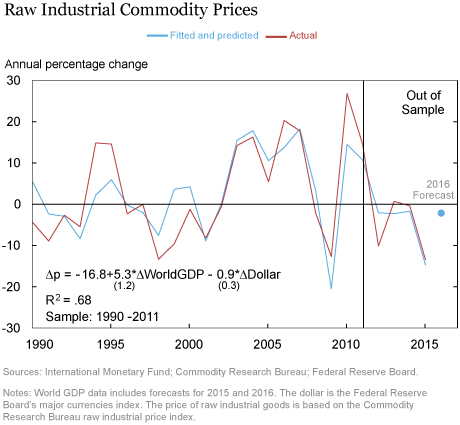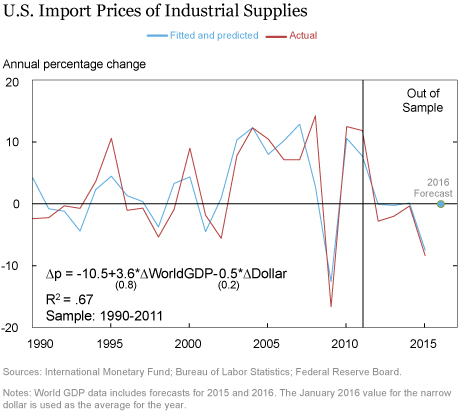Various news reports have asserted that the slowdown in China was a key factor driving down commodity prices in 2015. It is true that China’s growth eased last year and, owing to its manufacturing-intensive economy, that slackening could reasonably have had repercussions for commodity prices. Still, growth in Japan and Europe accelerated in 2015, with the net result that global growth was fairly steady last year, casting doubt on the China slowdown explanation. An alternative story relies on the strong correlation between the dollar and commodity prices over time. A simple regression shows that both global growth and the dollar track commodity prices, and in this framework, it is the rise of the dollar that captures last year’s drop in commodity prices. Thus a forecast of stable global growth and a relatively unchanged dollar suggests little change in commodity prices in 2016.
Prices Are Correlated with Global Growth
Commodity prices tend to fall when the global economy falters and rise when it is booming. The chart below compares global growth, as measured by the International Monetary Fund, with the annual percentage change in the Commodity Research Bureau price index for raw industrial goods (various metals, cotton, rubber, wool, and other goods). The two lines move together, with a regression using global growth having an R-squared of .52. That is, global growth explains around 50 percent of change in this commodity price index over this period. Looking at the chart, the closest co-movements are from 2004 to 2007—when the world economy was growing at an annual pace of more than 5 percent and the commodity price index was rising 15 percent per year—the collapse in growth in 2008-09, and the rebound in 2010-11. However, this relationship struggles to explain the 1995-96 and 2012-15 periods, with the latter being one of stable global growth and steep commodity price declines in both 2012 and 2015.
The stability of global growth does not necessarily preclude China’s flagging growth from having a significant role in the decline of commodity prices last year. In particular, China is more commodity-intensive than Japan and Europe and this shift in composition of growth last year is hidden in the global growth variable. Breaking down global growth into emerging and advanced countries reveals that the volatility of commodity prices is better captured by the growth of emerging economies than the growth of advanced economies. Some of this may be due to commodity prices affecting the economies of commodity-producing countries. Still, growth in emerging economies only slowed by half of a percentage point in 2015, so this variable is not enough to explain last year’s steep decline. Also, note that a regression using global growth does a better job tracking commodity prices than one that relies only on the growth of emerging economies.
Prices Are Also Correlated with the Dollar
Analysts looking for another explanation of last year’s price decline point to the strong correlation of commodity prices with the dollar—commodity prices tend to fall (rise) when the dollar appreciates (depreciates). One theory is that prices fall when the dollar strengthens because commodities priced in dollars become more expensive to the rest of the world, thereby restraining demand. It is a plausible explanation, but it is also quite possible that the dollar is not a causal factor and is instead correlated with other underlying factors affecting commodity prices.
The next chart shows these two data series with the dollar index of major currencies inverted so that the relationship is easier to see. (That is, a fall in the inverted dollar index means the value of the dollar is increasing.) Commodity prices show a strong correlation with the dollar, but not quite as strong as they do with global growth, with the R-squared statistic equal to .43. There are many time periods when the two variables move together, with 2015 being one such example.
So, what happens when these two variables are used together to track commodity price movements? The results of a regression show that the variables are each statistically useful in tracking commodity prices, with global growth and the dollar able to explain 68 percent of the movement in commodity prices. Note that the large coefficient on global growth offsets the large negative constant term, so that 3 percent growth in global output and a stable dollar would predict no change in commodity prices. As for the dollar, a 1.0 percent increase in this dollar index corresponds to a 0.9 percent drop in the commodity price index.
The regression does not use the whole sample in order to see how well the estimated coefficients fare in recent years. The out-of-sample prediction of the model starting in 2012 is pretty good. It under-predicts the drop in commodity prices in 2012, yields a 2 percent decline in commodity prices for both 2013 and 2014 when the index was unchanged, and does very well in predicting last year’s steep decline. The chart includes a forecast for 2016, using the IMF’s outlook for global growth and the dollar’s value in January and February 2016 as the average for the year. These assumptions, of a slight acceleration of global growth and a slight appreciation of the dollar, project that commodity prices will remain essentially unchanged this year.
Considering an Alternative Commodity Price Index
In case you are wondering if the results are driven by our choice of price index, we repeat this last exercise in the chart below using an alternative measure of commodity prices—namely U.S. import prices of industrial supplies, which includes a much broader array of commodity-type goods, such as steel and lumber. The results are similar, with global growth and the dollar capturing most of the movement in this price index. Again, based on the growth and dollar assumptions, the regression predicts the index will be stable in 2016.
Each commodity is influenced by a variety of supply and demand factors in its specific market. Nevertheless, the simple model presented here does well at tracking two broad commodity price indexes. That global growth helps explain commodity prices is not surprising, while the role of the dollar is more difficult to explain. Looking forward, the results suggest commodity prices will stabilize in 2016 if growth and the dollar unfold as expected.
Disclaimer
The views expressed in this post are those of the authors and do not necessarily reflect the position of the Federal Reserve Bank of New York or the Federal Reserve System. Any errors or omissions are the responsibility of the authors.
 Thomas Klitgaard is a vice president in the Federal Reserve Bank of New York’s Research and Statistics Group.
Thomas Klitgaard is a vice president in the Federal Reserve Bank of New York’s Research and Statistics Group.
 Harry Wheeler is a senior research analyst in the Bank’s Research and Statistics Group.
Harry Wheeler is a senior research analyst in the Bank’s Research and Statistics Group.















 RSS Feed
RSS Feed Follow Liberty Street Economics
Follow Liberty Street Economics
“However, this relationship struggles to explain the 1995-96 and 2012-15 periods, with the latter being one of stable global growth and steep commodity price declines in both 2012 and 2015.” You might want to take a look at another variable which is Corrected Money Supply for the US. A graph can be seen at http://www.philipji.com/item/2016-03-05/a-major-crash-is-on-the-cards-this-year. For your convenience I have uploaded a graph for the period from 1990 to 2016 which is at http://www.philipji.com/CMS-1990-2016-libertystreeteconomics.png This agrees much better with commodity prices for 1995-96 and 2012-15. I also venture to predict that because Corrected Money Supply Growth is approaching the 0% level, commodity prices will either continue to be low or there will be a major crash.
Looking at the supply side is a good suggestion. It seemed to us, though, that supply side variables are tied to individual commodities, making them less useful for understanding movements in a broad commodity price index.
You used global growth and the dollar as proxies for demand, but have you thought about incorporating any supply factors in your model?